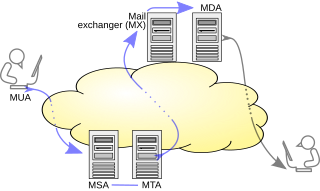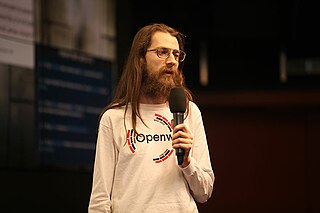
Paul Vixie is an American computer scientist whose technical contributions include Domain Name System (DNS) protocol design and procedure, mechanisms to achieve operational robustness of DNS implementations, and significant contributions to open source software principles and methodology. He also created and launched the first successful commercial anti-spam service. He authored the standard UNIX system programs SENDS, proxynet, rtty and Vixie cron. At one point he ran his own consulting business, Vixie Enterprises. In 2002, Vixie held the record for "most CERT advisories due to a single author".
The Simple Mail Transfer Protocol (SMTP) is an Internet standard communication protocol for electronic mail transmission. Mail servers and other message transfer agents use SMTP to send and receive mail messages. User-level email clients typically use SMTP only for sending messages to a mail server for relaying, and typically submit outgoing email to the mail server on port 587 or 465 per RFC 8314. For retrieving messages, IMAP is standard, but proprietary servers also often implement proprietary protocols, e.g., Exchange ActiveSync.

An open mail relay is a Simple Mail Transfer Protocol (SMTP) server configured in such a way that it allows anyone on the Internet to send e-mail through it, not just mail destined to or originating from known users. This used to be the default configuration in many mail servers; indeed, it was the way the Internet was initially set up, but open mail relays have become unpopular because of their exploitation by spammers and worms. Many relays were closed, or were placed on blacklists by other servers.
The Morris worm or Internet worm of November 2, 1988, is one of the oldest computer worms distributed via the Internet, and the first to gain significant mainstream media attention. It resulted in the first felony conviction in the US under the 1986 Computer Fraud and Abuse Act. It was written by a graduate student at Cornell University, Robert Tappan Morris, and launched on 8:30 pm November 2, 1988, from the Massachusetts Institute of Technology network.
The ancestor of sendmail, delivermail, also by Eric Allman, is a mail transport agent that used the FTP protocol on the early ARPANET to transmit e-mail to the recipient. Due to deficiencies in using FTP to send e-mail, a new protocol was created in 1981 for sending e-mail, SMTP. After DNS replaced hosts files, DNS-style host names were also adopted.

Eric Paul Allman is an American computer programmer who developed sendmail and its precursor delivermail in the late 1970s and early 1980s at UC Berkeley. In 1998, Allman and Greg Olson co-founded the company Sendmail, Inc.

Code Red was a computer worm observed on the Internet on July 15, 2001. It attacked computers running Microsoft's IIS web server. It was the first large-scale, mixed-threat attack to successfully target enterprise networks.
qmail is a mail transfer agent (MTA) that runs on Unix. It was written, starting December 1995, by Daniel J. Bernstein as a more secure alternative to the popular Sendmail program. Originally license-free software, qmail's source code was later dedicated to the public domain by the author.
Unix security refers to the means of securing a Unix or Unix-like operating system. A secure environment is achieved not only by the design concepts of these operating systems, but also through vigilant user and administrative practices.

Blaster was a computer worm that spread on computers running operating systems Windows XP and Windows 2000 during August 2003.

Postfix is a free and open-source mail transfer agent (MTA) that routes and delivers electronic mail.
Michał Zalewski, also known by the user name lcamtuf, is a computer security expert and "white hat" hacker from Poland. He is a former Google Inc. employee, and currently the VP of Security Engineering at Snap Inc.

A message submission agent (MSA), or mail submission agent, is a computer program or software agent that receives electronic mail messages from a mail user agent (MUA) and cooperates with a mail transfer agent (MTA) for delivery of the mail. It uses ESMTP, a variant of the Simple Mail Transfer Protocol (SMTP), as specified in RFC 6409.

Alexander Peslyak, better known as Solar Designer, is a security specialist from Russia. He is best known for his publications on exploitation techniques, including the return-to-libc attack and the first generic heap-based buffer overflow exploitation technique, as well as computer security protection techniques such as privilege separation for daemon processes.
The comparison of mail servers covers mail transfer agents (MTAs), mail delivery agents, and other computer software that provide e-mail services.
An Internet messaging platform is any system on the Internet that exchanges messages for the purpose of human communications.

OpenSMTPD is a Unix daemon implementing the Simple Mail Transfer Protocol to deliver messages on a local machine or to relay them to other SMTP servers. It was publicly released on 17 March 2013 with version number 5.3, after being in development since late 2008.

Sendmail, Inc. is an email management business.
The history of email entails an evolving set of technologies and standards that culminated in the email systems in use today.










